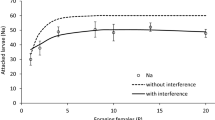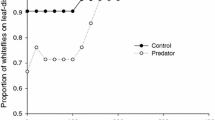Abstract
Larvae of Acanthoscelides obtectus show two contrasting behaviors when entering a bean. One is pioneer behavior in which a larva enters the bean through an entrance hole made by itself; the other is follower behavior in which a larva enters the bean through an entrance hole made by a pioneer. Previous studies have shown that the number of followers is much greater than that of pioneers. If there is a cost to being a pioneer, and if larvae can choose either of the two strategies, there is a dilemma: to be a pioneer or not. This dilemma is similar to the chicken game because if all larvae avoid choosing the risky pioneer strategy in favor of the follower strategy, none of the larvae can enter a bean, and they will die. In the present study, in order to investigate whether the larvae of A. obtectus are facing a dilemma of entry order, we experimentally measured the cost to pioneers and tested the flexibility of larval entering strategies. Pioneers’ costs were measured by entrance success rate, and the flexibility of larval strategies was tested by gauging the proportion of pioneers at various larval densities. The entrance success of pioneers was lower than that of followers, and the proportion of pioneers decreased as the number of competing larvae increased. These results suggest that the Pioneer-Follower interaction in A. obtectus satisfies the conditions for a dilemma game: the larvae of A. obtectus are in a dilemma of entry order.





Similar content being viewed by others
References
Anstett M, Bronstein J, Hossaert-McKey M (1996) Resource allocation: a conflict in the fig/fig wasp mutualism? J Evol Biol 9:417–428
Bronstein J, Hossaert-McKey M (1996) Variation in reproductive success within a subtropical fig/pollinator mutualism. J Biogeogr 23:433–446
Bronstein J, Vernet D, Hossaert-McKey M (1998) Do fig wasps interfere with each other during oviposition? Entomol Exp Appl 87:321–324
Frank SA (1984) The behavior and morphology of the fig wasps pegoscapus assuetus and p. jimenezi: descriptions and suggested behavioral characters for phylogenetic studies. Psyche 91:289–308
How RW, Currie JE (1964) Some laboratory observations on the rates of development, mortality and oviposition of several species of bruchidae breeding in stored pulses. Bull Entomol Res 55:437–477
Khadari B, Gibernau M, Anstett M, Kjellberg F, Hossaert-McKey M (1995) When figs wait for pollinators: the length of fig receptivity. Am J Bot 82:992–999
Kinoshita M, Kasuya E, Yahara T (2002) Effects of time-dependent competition for oviposition sites on clutch size and offspring sex ratios in a fig wasp. Oikos 96:31–35
Labeyrie V (1960) Nature de la repartition des larves d’Acanthoscelides obtectus Say. C R Acad Sci 251:149–151
Mitchell R (1975) The evolution of oviposition tactics in the bean weevil, Callosobruchus maculates (F). Ecology 56:696–702
Okamoto M, Tashiro M (1981) Mechanism of pollen transfer and pollination in ficus erecta by Blastophaga nipponica. Bull Osaka Mus Nat Hist 34:7–16
Parsons D, Credland P (2003) Determinants of oviposition in Acanthoscelides obtectus: a nonconformist bruchid. Physiol Entomol 28:221–231
Rapoport A, Guyer M (1966) A taxonomy of 2 × 2 games. Gen Syst 11:203–214
Simmonds MSJ, Blaney WM, Birch ANE (1989) Legume seed: the defenses of wild and cultivated species of Phaseolus against attack by bruchid beetles. Ann Bot 63:177–184
Szentesi A (1981) Pheromone-like substances affecting host-related behaviour of larvae and adults in the dry bean weevil, Acanthoscelides obtectus. Entomol Exp Appl 30:219–226
Thiery D (1984) Hardness of some fabaceous seed coats in relation to larval penetration by Acanthoscelides obtectus (Say)(Coleoptera: Bruchidae). J Stored Prod Res 20:177–181
Thiery D, Jarry M, Pouzat J (1994) To penetrate or not to penetrate? A behavioral choice by bean beetle first-instar larvae in response to Phaseolus vulgaris seed surface quality. J Chem Ecol 20:1867–1875
Umeya K, Kato T (1970) Studies on the comparative ecology of bean weevils V. distribution of eggs and larvae of Acanthoscelides obtectus in relation and boring behaviour. Res Popul Ecol 12:35–50
Utida S (1943) Studies on the experimental population of the azuki bean weevil, Callosobruchus chinensis (L.), viii. Statistical analysis of the frequency distribution of the emerging weevils on beans. Mem Coll Agr Kyoto Univ 54:1–22
Wiebes JT (1979) Co-evolution of figs and their insect pollinators. Annu Rev Ecol Syst 10:1–12
Acknowledgments
This work was supported in part by Grant-in-Aids for Scientific Research (0904115 and 12874101 to KF and YT, 14405003 to Masakazu Shimada, and 17579914 to YT) from the MEXT and JSPS. We thank Kazuharu Ohashi and Takashi Makino for helpful comments on the manuscript.
Author information
Authors and Affiliations
Corresponding author
Appendix
Appendix
We conducted an additional experiment that measures a competition between larvae of A. obtectus in a bean. We prepared beans (0.26 ± 0.02 g) and eggs laid within 72 h. We introduced one bean and 18 larvae into a sample bottle. After 10 days, we counted hatched eggs and larval carcasses around the bean and calculated the number of larvae in the bean. From that day, we monitored emergence of A. obtectus from each bean. The emergence probability without competition was 0.615 (one bean–one larva; 0.65 for pioneer, 0.58 for follower in Table 1). We plotted emerging probability of each larval density in a bean and conducted linear regression analysis (Fig. 5; y = 0.000442x + 0.598224, P = 0.8541). The slope of regression was not significant, and there is no effect of competition for emergence within the range of density used (2–14).
About this article
Cite this article
Ohtsuka, Y., Toquenaga, Y. Pioneer-Follower dilemma game in Acanthoscelides obtectus (Coleoptera: Bruchidae). J Ethol 27, 131–136 (2009). https://doi.org/10.1007/s10164-008-0096-x
Received:
Accepted:
Published:
Issue Date:
DOI: https://doi.org/10.1007/s10164-008-0096-x




